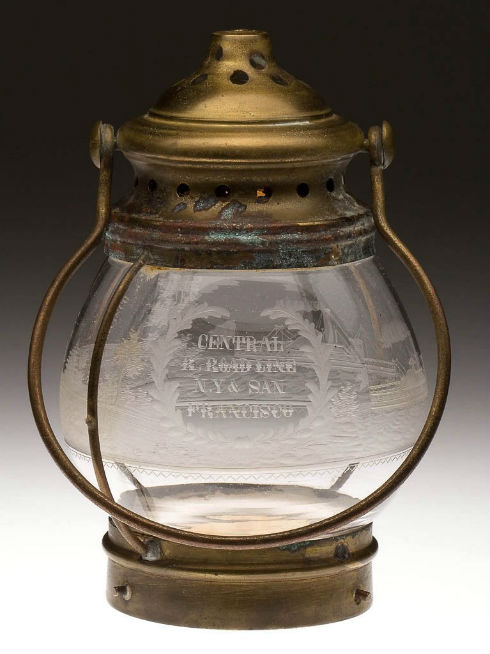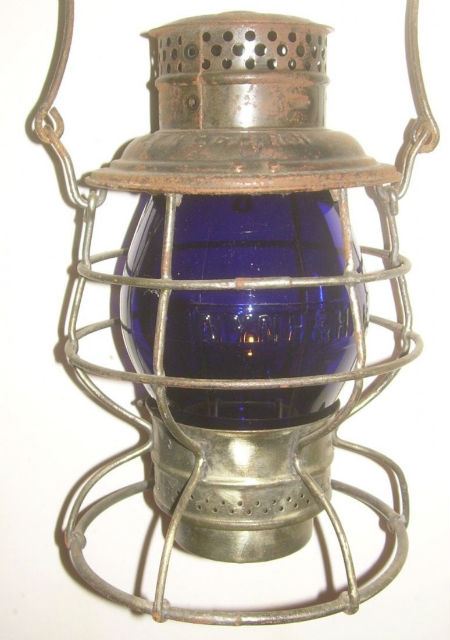
NEW YORK – Before the advent of electricity and power lines, railroad lanterns played a key role in keeping trains running safely at night. In the early days of the 1870s, lanterns were not standardized and came in a variety of shapes and sizes. Today, original lanterns, particularly those with their glass globes intact, are highly collectible.
According to the Railroad Collectors Association Incorporated, lanterns were once an integral tool for railroad workers and used when relaying signals and inspecting trains at night. “While modern electric lanterns are still used in railroad service, most collectors look for earlier lanterns that burned kerosene, signal oil, or other types of fuel.” Among collectors, any lantern or globe that carries a railroad marking is especially valued. The rarest markings command the highest values, the association notes on its website, which details types of collectible railroadiana from lanterns and badges to passes and postcards.
The Transcontinental Railroad was built during the peak of the Industrial Revolution in America, bringing thousands of people west. In 2019, the 150th anniversary of the union of Central Pacific and Union Pacific railroad tracks at Promontory Summit, Utah, was celebrated. A golden spike driven into the ground there May 10, 1869, linked the two railroad lines that began in San Francisco and Nebraska respectively.

Jeff Polston has a website dedicated to railroad lanterns here and says desirable lanterns run the gamut of styles. “Some people collect certain road names and some road names are much more rare,” he said. “In general, older lanterns are more collectible than newer lanterns, which shows in their values. For example, a tall globe lantern generally brings more than a short globe lantern.”
Among the most collectible types are presentation lanterns, according to Railroad Collectibles. “Presentation lanterns, sometimes known as conductor’s lanterns, were often given as a gift or commendation upon a conductor’s retirement or achievement of a significant milestone.” These were also sometimes presented as a reward for a heroic deed such as saving lives from a train crash. Often engraved, the lanterns also feature embossed or etched globes. More elaborate examples will use two colors of glass in the globes. With solid provenance, coveted features and in good condition, these lanterns can fetch several thousand dollars.

Fixed globe lanterns also bring substantially more than a tall globe lantern, Polston said. “Certain color globes, like blue, green or amber are generally more collectible than clear and red. Marked globes with the road name are more collectible than plain globes. Collectors also love conductor lanterns and brass top lanterns. Those are often the jewels of collections.”
The colors of the globes and the manner in which workers swung the lanterns conveyed certain meanings when railroad crews used them for signaling. Clear globes and red were most common but there were also yellow (ranging from a light-yellow hue to a deep yellow, almost orange), green and blue globes. Like traffic lights, red means stop and clear/white lanterns could be used to halt a train at a flag station. “The blue lantern was used for marking equipment that wasn’t to be moved. It was hung on the various equipment, such as boxcars or locomotives, that were being worked on,” Polston said, noting a green lantern was used as a tower signal for “proceed with caution.” One use for the yellow lantern was to point out “camp cars” where repair men could stay when working on train cars.

“The main things collectors will pay attention to are what railroad the lantern is from (i.e. the railroad marked on it), the type of globe (i.e. size, color and markings), and finally the particular model and maker of the lantern itself,” according to Railroad Collectibles.
Lanterns that came from certain railroads tend to be more heavily collected than others, but in general, popularity leans toward the more well-known larger passenger railroads. “When it comes to value, though, the most valuable pieces are often from early predecessor railroads that were eventually merged into a bigger one,” according to Railroad Collectibles. The writers noted these items tend to be older and fewer in number.

An appealing thing about collecting railroadiana is its popularity over the decades makes it quite accessible. Railroads had many lanterns manufactured so there are many examples on the market today. While the availability of inexpensive and common lanterns far outstrips the rare, more expensive lanterns, collectors can find choice items in all price points. New collectors need to check for authenticity as lanterns can be faked to look old. Modern globes can be cast to resemble their antique counterparts and metal stamping on lantern bodies can be replicated.
Railroad lanterns don’t take up a lot of room and are easy to display. Even better, they can be used to add interesting accent lighting to one’s home.


